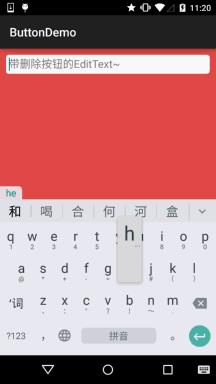自定义View——加强版的EditText
Posted 鹏达君
tags:
篇首语:本文由小常识网(cha138.com)小编为大家整理,主要介绍了自定义View——加强版的EditText相关的知识,希望对你有一定的参考价值。
1.如何加强?
输入内容后,有面会显示一个图片,用户点击后 可以清空文本框。
2.案例构造步骤
1)在drawable文件中建一个bg_frame_search.xml文件。
<?xml version="1.0" encoding="utf-8"?> <shape xmlns:android="http://schemas.android.com/apk/res/android" > <solid android:color="@color/background_white" /> <corners android:radius="5dp" /> <stroke android:width="1px" android:color="@color/frame_search"/> </shape>
2)在drawable中放置你要显示的图片,图片名称为:delete_gray。
3)书写自定义view。
import android.content.Context;
import android.graphics.Rect;
import android.graphics.drawable.Drawable;
import android.text.Editable;
import android.text.TextWatcher;
import android.util.AttributeSet;
import android.view.MotionEvent;
import android.widget.EditText;
/**
* Created by 刘鹏达 on 2017/12/9.
*/
public class DelEditText extends EditText {
private Drawable imgClear;
private Context mContext;
public DelEditText(Context context, AttributeSet attrs) {
super(context, attrs);
this.mContext = context;
init();
}
private void init() {
imgClear = mContext.getResources().getDrawable(R.drawable.delete_gray);
addTextChangedListener(new TextWatcher() {
//内容变化前
@Override
public void beforeTextChanged(CharSequence s, int start, int count, int after) {
}
//内容正在改变
@Override
public void onTextChanged(CharSequence s, int start, int before, int count) {
}
//在内容改变完之后
@Override
public void afterTextChanged(Editable editable) {
setDrawable();
}
});
}
//绘制删除图片
private void setDrawable(){
if (length() < 1)
setCompoundDrawablesWithIntrinsicBounds(null, null, null, null);
else
setCompoundDrawablesWithIntrinsicBounds(null, null, imgClear, null);
}
//当触摸范围在右侧时,触发删除方法,隐藏叉叉
@Override
public boolean onTouchEvent(MotionEvent event) {
if(imgClear != null && event.getAction() == MotionEvent.ACTION_UP)
{
int eventX = (int) event.getRawX();
int eventY = (int) event.getRawY();
Rect rect = new Rect();
getGlobalVisibleRect(rect);
rect.left = rect.right - 100;
if (rect.contains(eventX, eventY))
setText("");
}
return super.onTouchEvent(event);
}
@Override
protected void finalize() throws Throwable {
super.finalize();
}
}
4)引用自定义view
布局:
<LinearLayout xmlns:android="http://schemas.android.com/apk/res/android"
xmlns:tools="http://schemas.android.com/tools"
android:layout_width="match_parent"
android:layout_height="match_parent"
android:background="@color/back_red"
android:orientation="vertical"
tools:context=".MainActivity">
<com.example.edittextzdy.DelEditText
android:id="@+id/edit_search"
android:layout_width="match_parent"
android:layout_height="32dp"
android:layout_margin="10dp"
android:background="@drawable/bg_frame_search"
android:hint="带删除按钮的EditText~"
android:maxLength="20"
android:padding="5dp"
android:singleLine="true" />
</LinearLayout>
activity:
import android.support.v7.app.AppCompatActivity;
import android.os.Bundle;
public class MainActivity extends AppCompatActivity {
@Override
protected void onCreate(Bundle savedInstanceState) {
super.onCreate(savedInstanceState);
setContentView(R.layout.activity_main);
}
}
效果图:

总结:大家看了这几个案例之后,只是知道了,哦,我要实现自定义view大概应该怎么去操作,但对操作的底层,或者说本质却有点模糊,所以之后我们就来谈谈自定义view的深入了。
以上是关于自定义View——加强版的EditText的主要内容,如果未能解决你的问题,请参考以下文章